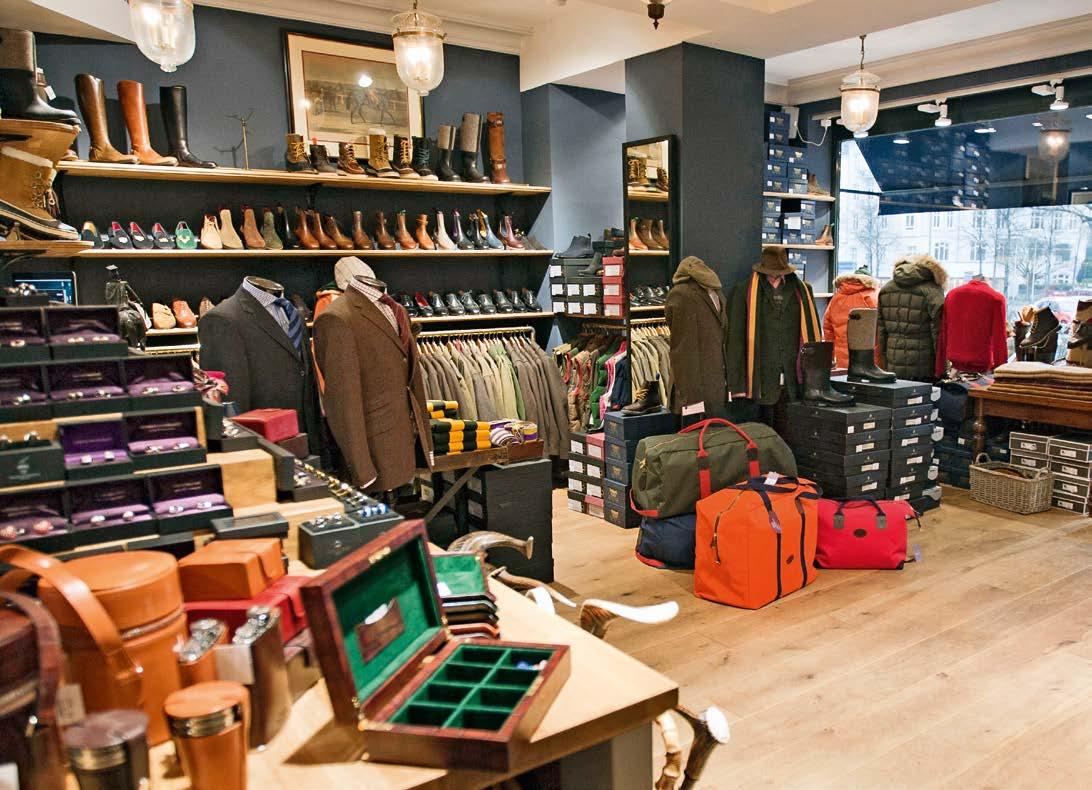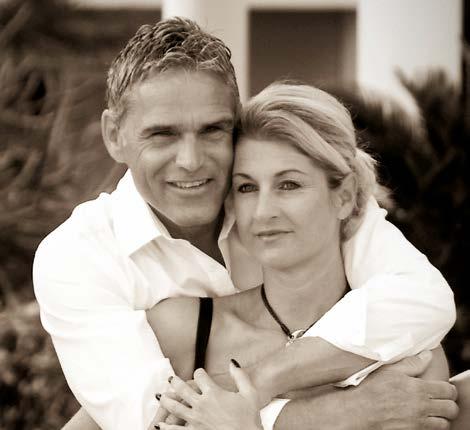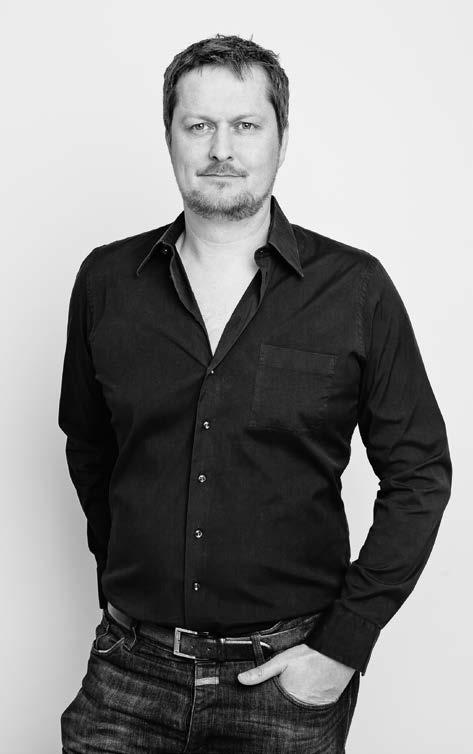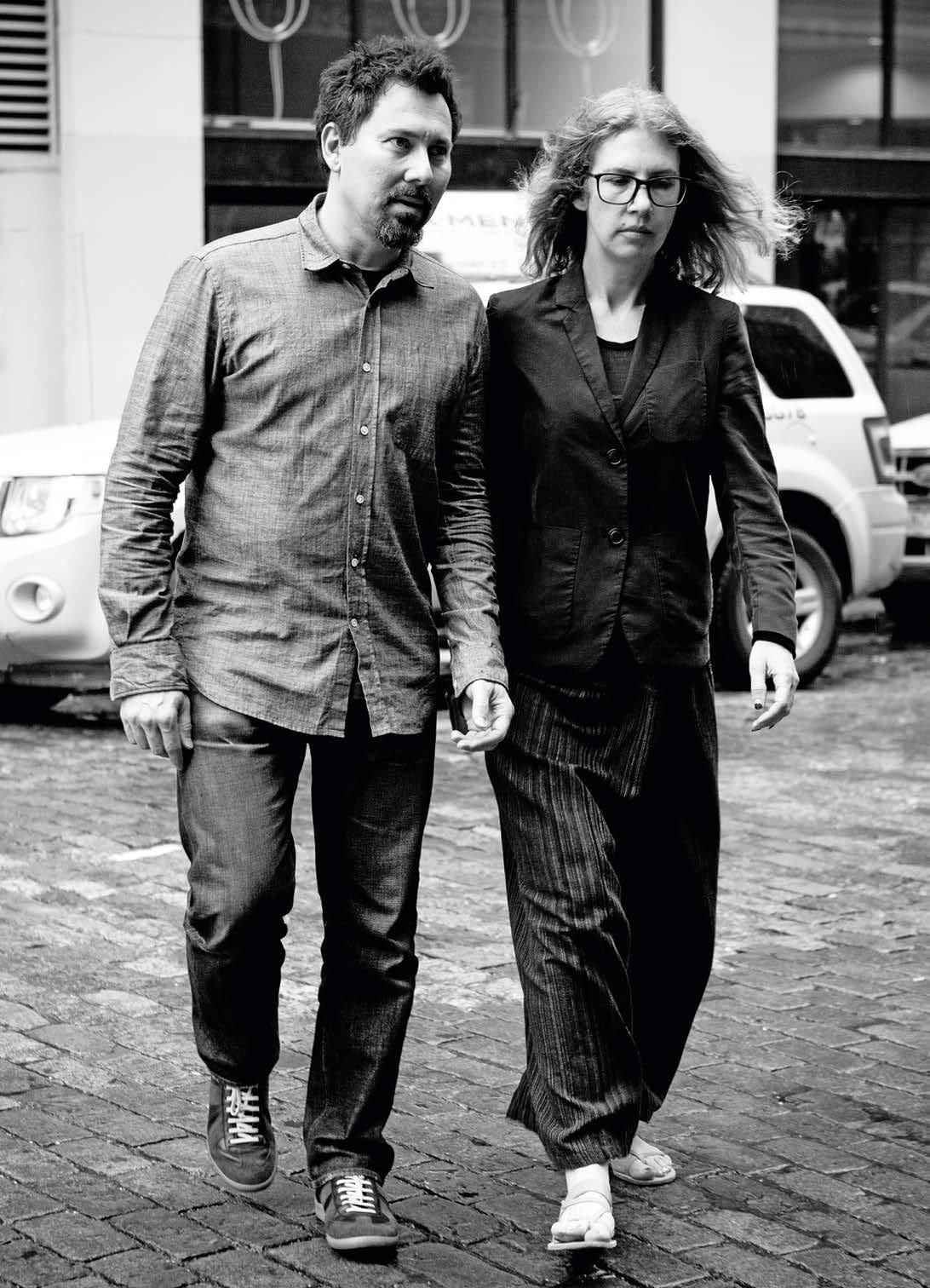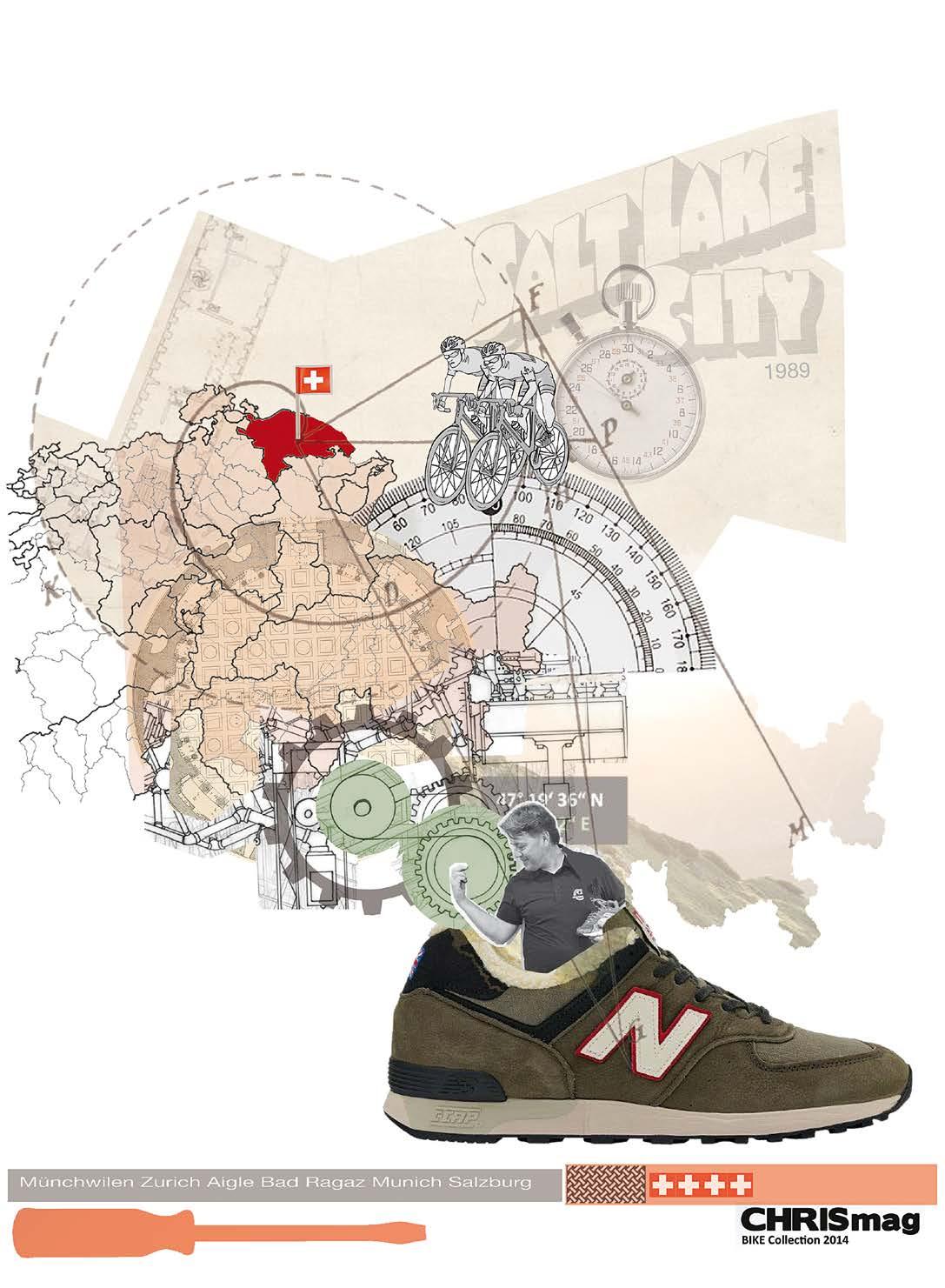
25 minute read
Don’t be so pessimistic
064 WHAT'S THE STORY Don’t be so pessimistic!
Why shoe ranges deserve some courage.
Are shoe purchasers inhibitors of creativity? The majority of consumers never lay eyes on the beautiful eccentric models that shoe designers conjure up. It almost seems as if it’s easier to market special products online.
Text: Ina Köhler. Illustration: Graham Wiseman. Photos: Dialogue partners
There it is - the object of our desire. A shoe that shouldn’t even be on display in Salzburg’s shopping street Getreidegasse. It has no sole and no fastener. It’s a little piece of art, which probably means that it is fairly difficult to sell… Nevertheless, this shoe designed by London-based architect Julian Hakes found its way into a retail outlet. The story behind it goes something like this: The Brit Hakes developed a shoe prototype that rather follows the laws of architecture than the rules of classic footwear fashion. It distributes the vertical load between the ball and heel. It’s spectacular and beautiful, but not commercial at all. Hakes published some of his drawings online and subsequently supplied his prototypes to designers at the London Fashion Week. Both consumers and the press posted enthusiastic comments. Today, the model named “Mojito” is available in all kinds of colours and finishes. Hakes even received an award from “Draper’s Footwear”.
The Purchaser as Inhibitor
Despite all the media enthusiasm, it is not commonplace for such products to enter the retail space. Only too often the purchaser is the bottleneck through which new products have to pass. But Hakes found a partner who believed in him. “Julian Hakes offers an interesting new product that has not been on the market in this form”, says Stephan Krug, the managing director of Highline United and Hakes’ distribution partner. “Highline United was convinced by the idea, decided to realise this exciting project, and to ensure that this exclusive shoe reaches the consumers.” According to his experience, it was not very difficult to persuade stationary retailers. “Progressive specialised retailers instantly recognised the unique selling proposition of Julian Hakes’ Mojito shoe and were willing to add it to their product range immediately.”
Creative Design = Non-marketable?
Deluxe Distribution’s Ilya Morgan also has experience with unusual designs from working with the shoe brand United Nude. The brand first rose to fame due to the eccentric models named “Möbius” and “Eamz” designed by founder Rem D. Koolhaas. “We have an iconic product
Stephan Krug, Highline United
Ilya Morgan, Deluxe Distribution

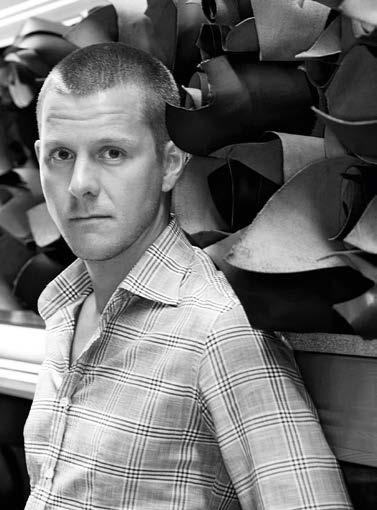
“In Germany we currently don’t sell the same range of the collection as in - for instance - the
Netherlands and Belgium." Pepijn van Bommel, Floris van Bommel
design and we also regularly co-operate with other designers such as Iris van Herpen”, Ilya Morgan explains. “The shoe design divides opinions - some love it, while others don’t understand it at all.” However, the customers are more audacious than he expected. This is especially true for online retailers such as Zalando. “The buyers like the product and wear it themselves. And that platform offers really eccentric models.” But there are high-profile stationary retailers on the customer list too. These include the likes of Galeries Lafayette, the KaDeWe, and The Corner. However, United Nude went through a strategic realignment process a year ago. To appeal to a wider range of customers, the brand now also offers more commercial models. Is this a compromise or a necessary decision to convince buyers?
Brave New Consumer World
If one takes a short glimpse of the product ranges available on the Internet, it seems - at first - as if the consumer has more choice. You can choose from all sorts of colours and shapes ranging from plain to super extravagant models. Unfortunately, one only too often finds out that the photo is not backed by a real offer. And are purchasers for online stores really braver? “International shops need to buy for various markets, which automatically makes the product range look broader due to the fact that they have to serve different countries”, says Moderaum Fischer’s Lars Fischer, who is a representative of the brand Fratelli Rossetti. “One has to question whether they really turn over a large number of individual models.” Kurt Denkstein, the distributor of brands such as Pretty Ballerinas and Mascaró, has a similar opinion. “You have to bear in mind that not everything depicted on the Internet is really available. The diversity offered on the Internet can attract the interest of consumers and may even inspire people to visit stationary retailers to see whether they can find the product there.” Moreover, one can often only find a limited number of a certain shoe model online. “The recipe for success for stationary shoe retailers is to offer a product in depth, not merely a wide range of products. This is something our distribution department can influence”, Denkstein argues.
Cross-linking Distribution Channels
Retailers that cover both channels need an excellent strategic concept. The trick is to coordinate the products both offline and online, at least that’s the opinion of Graz-based Leder & Schuh AG. “Everything that’s available in the store, should also be available online - and vice versa”, says Heinzpeter Mandl, a member of the management board. “We could expand the product range on the website with the suppliers via drop shipments (the partner holds the stock and organises shipments), but that is currently not the focus of our business.” A drop shipment means that the supplier merely provides product images for the retail partner. The risk is shouldered by the brand itself, not by the retailer. This suggests an infinite assortment range to the consumer. “Online retailing gives you an opportunity to experiment and to show what a huge product range you have. Additionally, it generates customer frequency regardless of opening hours”, Mandl explains. But despite all the enthusiasm for the digital business, he still calls for a competent purchasing division that knows exactly which product it buys for which kind of customer. “If you have a huge green-field warehouse, you could theoretically expand the range of your product portfolio infinitely. For stationary outlets I need to be more focused due to a limited sales area and need to decide in which product modules I want to invest more… and finally it is necessary for retail chains to address the issue of which product range is offered in which branch area”, Mandl says. This is a rather tricky question. The 360 outlets run by Leder & Schuh under the brand concepts Corti, Humanic, Dominici,
"Stationary shoe retailers need depth, not just a wide range of products!"
Kurt Denkstein, Agentur Denkstein


“When it comes to purchasing, we make sure that we tell a story. At best, the customer connects at an emotional level and is even
surprised.” Rebecca Herkenrath, Herkenrath 1873
“Everything that’s available in the store should also be available online
- and vice versa.” Heinzpeter Mandl, Leder & Schuh AG

Stiefelkönig, and Shoe4You are spread out over ten countries. The sites include prime locations such as Cologne’s Schildergasse or Vienna’s Mariahilferstrasse, but also smaller towns such as Wels, Dornbirn, and Mönchengladbach.
Brain and Gut
Emotion is a key element that is often mentioned in connection with purchasing. Rebecca Herkenrath, a buyer for the high-end multi-brand shoe retailer Herkenrath 1873 in Cologne and Düsseldorf, also believes that purchasing should be based on gut feeling. “Especially with new products I rely on whether the item appeals to me on an emotional level. The price-performance ratio must be right too of course.” Heinzpeter Mandl has a similar opinion and is convinced that intuitive decisions are essential despite guidelines: “The buyer needs to find a balanced mix of gut decisions and pre-defined structures in regard to factors such as price, brands, suppliers, and branches.” Even new labels in the product range have to be characterised by an attractive product; a strong well-known brand would promote this. However, many buyers opt for supposedly safe models. “A little more risk-taking would be nice. This shoe here is a good example”, Lars Fischer explains at the trade show booth of Fratelli Rossetti. “Everyone is looking at the colourful embroidered model, but hardly anyone actually orders it. I still display it anyway, so I can ultimately sell the black or brown ones.” Online consumer behaviour supports this conservative buying pattern. “Our online top-seller is the black ballerina”, Kurt Denkstein reveals. Naturally this influences the purchasing division. “People are often afraid to try something new, which is why they focus on the supposedly safe choices”, Lars Fischer muses. “The result is that I see the same product range between Flensburg and Bodensee.” Ultimately, the product has the potential to differentiate a retailer from competitors. “It always depends on the buyer”, says Rebecca Herkenrath. “I have often witnessed that two buyers were in the showroom of a brand at the same time, but that the result in the shop window or the store was very different in the end.”
Storytelling and Individuality
Obviously economic considerations play their part. The brands have a strong interest in advising their customers in a manner that makes their products more saleable. “In Germany we currently don’t sell the same range of the collection as in - for instance - the Netherlands and Belgium”, says Pepijn van Bommel, the commercial director of Floris van Bommel. This means that the average product portfolio is less extravagant than in the neighbouring markets. “For us it is important that a retailer does not only buy eccentric styles, but a good mixture of commercial and highly extravagant models. At the end of the day it’s all about business.” Nevertheless, especially in times of comparable product ranges, emotionality and individuality are key issues when it comes to purchasing. Sometimes one wishes the buyers would be a little more audacious. “When it comes to purchasing, we make sure that we tell a story. At best, the customer connects at an emotional level and is even surprised”, says Rebecca Herkenrath. “If customers only find what they expected, it gets boring. That’s why it is so important to purchase individually. We even place a different emphasis on our product ranges in Cologne and Düsseldorf; our customers reward this approach.”
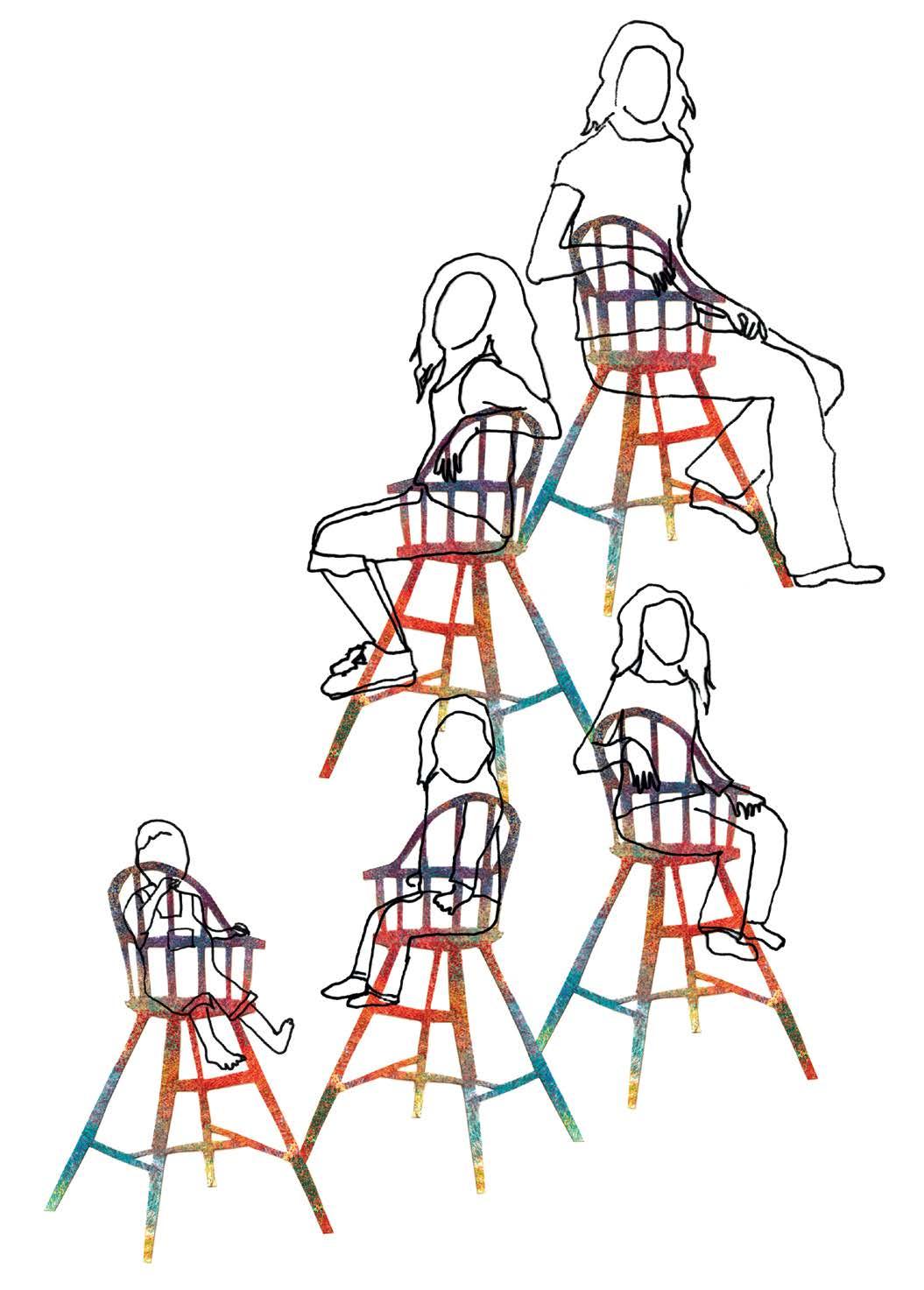
Growth Pains
The dress label Liebig has put its collection on ice and the founders of Firma Berlin have decided to quit altogether after 17 years. Such examples reflect the current market pressure and raise the question if and how an independent fashion label can enjoy long-term success.
Text: Nicoletta Schaper. Photos: Brands. Illustration: Esther Gebauer @Caroline Seidler “There is no independent label without investor; every young designer would otherwise remain as small as the bakery on the corner”, says Volker Tietgens. Since 2008, the private investor owns a 40% stake in Kaviar Gauche and a 50% stake in Michalsky Holding. “I fell in love instantly with the elegiac dresses by Kaviar Gauche”, Tietgens explains. “Kaviar Gauche is a small, bright label with a structure that enables it to work well with relatively little financial support and it grows in small steps. Michael Michalsky already had a successful design career at Adidas and Levi’s, which means he has a completely different background than most of his peers. I find that business approach interesting.” Today, the company Michalsky is based upon three pillars; alongside fashion for men and women, it also has a licensing business and runs Michalsky designLab, an agency via which Michael Michalsky realises various other design-related projects. “We have achieved break-even in the licensing and design project segments”, says Tietgens, who is also the second chief executive at Michalsky. “It will probably take a few more years before the fashion collection reaches that point. The biggest surprise for me was how slow the industry actually is. A retailer monitors a collection for a couple of seasons before deciding to replace an already established brand.” Today, Michalsky has 100 points of sale in German-speaking countries, but Tietgens believes that the potential is by no means exhausted. “The press often tells us that we need to showcase our collection in Paris to be successful. I don’t see it that way. Our home market is large enough and we first need to build on our success here.” However, Volker Tietgens is aware of the fact that the ongoing structural change exacerbates the situation. “It is more difficult for designer labels to enter the market, mainly because vertically integrated players increasingly attack the core competence of independent multi-brand retailers. That’s why it is important for Michalsky to focus on big online retailers such as Zalando. “The market impact also helps the stationary retailers”, Tietgens explains. “Overcautious selective distribution is a thing of the past.”
Clever Coup
Olivia Pflugfelder-Jünger and Sandra Liermann had less luck in finding a financially strong partner, even though their label Liebig had a promising start. In 2008, when the dress segment was almost exclusively covered by Diane von Fürstenberg, the two businesswomen focused on uncomplicated silk dresses and handed them on to their girlfriends and the press. The plan was a success and the enthusiasm was great. Due to the distribution agencies Kappler and Baessler, as well as a presence at the Premium trade show, Liebig managed to win over renowned retail customers such as 14 oz., Anita Hass, Lodenfrey, and Off & Co. The collection, consisting of 25 dresses per season, was perfectly balanced too. “Of course we were expected to evolve continuously”, Olivia Pflugfelder-Jünger acknowledges. “The collection grew in size, especially when we started to take the opinions and wishes of the retailers.” The label experimented with new materials such as viscose and velvet, which was only partially accepted by the retail industry. “As a small label that is always the last to be supplied by producers, it is not easy to manage four collections per year. You hardly have time to breathe.” At the same time, the financial pressure increased with larger quantities. Olivia Pflugfelder-Jünger: “You finance every season six to seven months in advance, pay at least 50% in advance for fabrics, and the invoice is often on your desk one day after the order has been placed with the producer.” Then there are the problems relating to retailers. “Some expected us to take back and credit unsold items at the end of the season. Moreover, the large regular suppliers are often paid long before the smaller brands.” Last October, the label did not have sufficient funds to finance the spring/summer 2014 collection. After negotiations with a potential partner failed, Sandra Liermann and Olivia Pflugfelder-Jünger decided to put Liebig on hold and reconsider the label’s set-up.
Start-Up Money
These days, only those who can offer collaterals can enjoy the support of the banks. However, smaller companies often don’t have the financial buffer to pre-finance the next fashion season. Carl Tillessen and Daniela Biesenbach won a lot of awards when they started their project Firma. The company won prestigious prizes such as the Best International Designer Award from the German men’s fashion institute in 2001 and the “Golden Nose” award from the fashion press. In 2006, when Firma launched its women’s collection, the company won the Electrolux Fashion Award for the best collection at Prêt-à-Porter Paris. However, the monetary rewards are often merely the proverbial drop in the bucket for young design labels. “One mostly receives financial support for the debut collection, but at that time a label is still miles away from being viable”, Carl Tillessen says. “The support often lacks sustainability, which means there is a huge gap between starting aid and actual viability.” In the end Firma had 60 customers worldwide. “We received over
Carl Tillessen, managing director at Firma Berlin: “We
didn’t run out of money. We just don’t see a way forward anymore.”
The cashmere hats by Warm-Me have filled a market gap.


The brand core of Villa Gaia is knitted cashmere manufactured on hand-knitting machines.
Thomas Brugger, managing director at Warm-Me: “We
have found the perfect niche for us; unique products always work. Furthermore, we benefit from our core competence distribution and have complemented that with design competence.”
Norbert Reipert, managing director at Villa Gaia: “The retail industry needs diversity. Mentorship is vital to achieve this.” whelming feedback last season. However, this customer feedback and the realisation that we still hadn’t progressed an inch from an economic point of view was a clear signal to call it a day”, Tillessen explains. “For every new customer, another customer gave up his business. At the same time, retailers cut their budgets. That’s why our business was stagnating.”
Niche and Network
The distribution structure that others have to painstakingly build, laid the foundation for the label Warm-Me. When Christian and Iris Obojes, the owners of the fashion agency room with a view, failed to find a premium hat label, they simply decided to start their own. At the 2011 Premium trade show they presented Warm-Me cashmere hats that were ordered by 50 customers straight away. On the one hand because the innovative product precisely fills a market gap, on the other because the label benefitted greatly from the agency’s network. It also helped that the retailers trust Christian Obojes’ judgement. “Warm-Me has developed beautifully”, managing director Thomas Brugger confirms. “We now sell 10,000 hats per year to 260 customers worldwide and continue to grow.” Warm-Me also profits from the fact that it is an uncomplicated product without fit problems and that everyone can focus on individual strengths. “The key positions are well covered by five people”, says Thomas Brugger, who is responsible for the financial side of the business. Initially, the small label was backed by Issue Modehandel GmbH, a company founded for the import labels of the agency. In May 2013, WarmMe GmbH was founded and has even managed to generate a small profit. “Now we want to grow internationally. We do notice the worsening payment behaviour of some retailers. It is important to compensate that with other markets.” Thomas Brugger points out that the online business needs to be expanded too. “I don’t see any danger of the label showing up on the Internet too often, mainly because of our elevated price structure with retail prices between 130 and 250 Euros.”
Vertical Role Model
Villa Gaia’s Norbert Reipert and Simone Zick also animate customers to sell their collection - founded in 1993 - online. The label initially generated growth via its private customer base. Since 2003, Villa Gaia is a regular exhibitor at the Premium trade show and has been, on average, growing by 40% per
The Liebig collection was focused on uncomplicated silk dresses.
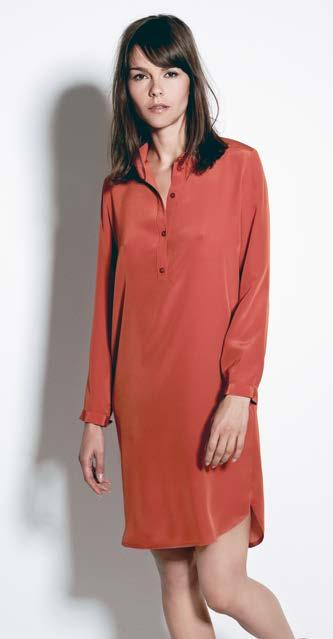
Fashion is the third pillar of Michalsky Holding alongside the licensing business and various design projects.

Firma Berlin has decided to call it a day after 17 years.
season ever since. “Our growth amazes us, especially as the industry is not doing so well”, Norbert Reipert says. “The banks no longer finance the retailers’ pre-order, mainly because the banks are under pressure too. In addition, the low interest policy has caused the rents for prime locations to soar, which makes it difficult for multi-brand retailers to pay them.” The strategy of Villa Gaia is nevertheless successful. The brand essence consists of cashmere items produced on hand-knitting machines. The key strength is the ability to knit to size, which makes the company more flexible than most larger suppliers. Thus, the retail customers don’t need to commit too early and can order goods on short notice. This process is made even easier by the fact that the label produces in Europe, which is close to the points of sale. Villa Gaia has managed to raise its average revenue per retailer to 10,000 Euros. The company with 50 employees is also hugely successful on a vertical level; it runs two stores of its own in Prien am Chiemsee and Rosenheim. “Those stores contribute 25% to our overall revenue”, Norbert Reipert reveals. “We are successful because we care for our business and evaluate everything very closely.” But even successful companies need to face the odd error or mishap. A Villa Gaia store failed to flourish due to a bad location and the factoring company had to file for insolvency in June 2011. Then - to top it all off - came a winter that didn’t really deserve the name. “We were suddenly sitting on too many goods”, Reipert says. The company found a silent partner to ensure that all obligations can be met and secure further growth. “We will be able to pre-finance the next season from our own cash-flow in two years time.”
Mentors and Patrons
The founders of Liebig can imagine going back to the roots in the future. One option would be to focus on producing the best silk dresses and distribute them via an online shop and other exclusive e-commerce platforms. Carl Tillessen would, in the event of a fresh start, focus on a range defined by craftsmanship. It would be a concept similar to Werkstatt Munich, but even more luxurious and pointed. “Fashion is a lot more individual than the things that are currently dominating the market”, Norbert Reipert says. “It would be great if our industry could find mentors to look over the shoulders of young talents and offer them sales areas. The retail industry needs diversity. Mentorship is vital to achieve this.”
Olivia Pflugfelder-Jünger, managing director at Liebig:
“The risk cannot be shouldered by the label alone.”
Volker Tietgens, managing director at Michalsky: “The
press often tells us that we need to showcase our collection in Paris to be successful. I don’t see it that way. Our home market is large enough and we first need to build on our success here.”
Women + Technology
Wrangler . The traditional label belongs to the exclusive club of truly authentic American brands. However, an illustrious history is no guarantee for future success.
Text: Ina Köhler. Photos: Wrangler The history of Wrangler dates back to the year 1904. While other brands have to cumbersomely build authenticity and history, this jeans brand has plenty of it to offer. The difficulty caused by such a long brand history is to rejuvenate the target group without losing the classic buyer. Jeans were seen as a mere commodity in the 1990s, but the demands on the product and the image of brands have increased. “A brand with such a long history has to live up to a totally different set of standards”, says Matthias Herrmann, the sales director responsible for Germany, Austria, and Switzerland. After conducting extensive consumer research in respect to Wrangler’s target group the findings were used to create a strategy that focuses heavily on the product itself. The result is titled “Denim Performance” and has produced innovations such as jeans that keep warm due to an integrated hollow fibre named “Thermolite”, water resistant jeans, and cooling jeans. “Our typical customer wants good quality and an additional benefit for his hard earned money. Our products are unique in the market”, Herrmann explains. They are long lasting too. The jeans model named Texas has been on the market for no less than 25 years and is one of the best selling zipfly models.
Desirable Target Group: Women
Women were once an important target group for Wrangler. They have moved back into the focus of the brand recently, also with new product ideas. “Live in Denim” is the new slogan under which innovations such as “Shape Keeper”, “Silk Soft”, and the successful “Denim Spa” range are being launched. For example, some jeans finishes include argan oil, which nurtures the skin. “We had quite a large reaction in the press and among customers”, Herrmann explains. The women’s fashion sales are expected to double by 2015; the same applies to the share of total sales, which currently stands at 25%. Germany, Austria, and Switzerland are key markets for Wrangler within Europe. Herrmann points out that the Wrangler brand is growing faster than the market again after its target group and collection statement are more focused: “2013 was a very good year for us and we expect to enjoy further growth in 2014.” The target for 2014 is a 10% growth rate. VF Corporation plans to invest more in Europe’s core market. A major consumer campaign with racing driver Kimi Räikkönen as brand ambassador will be launched this autumn.
Investment in Retail
Retail expansion is also an integral part of Wrangler’s strategy, both on its own steam and with co-operation partners. On April 17th, a 70 square metre Wrangler store opened in the Limbecker Platz shopping centre in Essen. It is the second of its kind after the first Wrangler
Matthias Herrmann: “Our products are unique in the market.”

store opened in Leipzig in 2012. This new store will act as a blueprint for further shops with an authentic look, which will either be run by Wrangler itself or in co-operation with retailers. “What is important to us is to secure the right locations with a good tenant mix. This includes both a downtown location as well as a well-managed shopping mall”, Hermann says. Wrangler plans to run 30 partner stores by 2017, of which five are expected to be realised over the next two years.
Wrangler
Roughly 110 years ago, Charlie Hudson founded the Hudson Overall Company in Greensboro/North Carolina, which then changed its name to Blue Bell Company in 1919. Greensboro is also the location of the headquarters of VF Corporation, the largest clothing company worldwide, which acquired the Blue Bell Holding in 1986. In the last fiscal year, VF Corporation’s sales amounted to 11.4 billion Dollars (8.3 billion Euros). The portfolio of VF Corporation does not only include jeans brands like Lee or 7 For All Mankind, but also brands such as Nautica, Timberland, The North Face, Vans, Eastpak, Napapijri, Reef, and Splendid. www.wrangler-europe.com
On Track for Becoming a Brand
0039 Italy . Innovative tops that make classic blouses look old - that’s what 0039 Italy is renowned for. But who would have connected the name with a complete fashion collection?
Text: Nicoletta Schaper. Photos: 0039 Italy When a TV channel aired a portrait of 0039 Italy founder Aysen Bitzer-Bourak in May as part of a programme about successful German women, it had an immediate effect. “Our store in Stuttgart was particularly busy; our online shop also experienced a peak in customer traffic”, Aysen Bitzer-Bourak says. She founded the label 0039 Italy 14 years ago with the aim of revolutionising the blouse segment. She immediately won over top German retailers with her passion for the product. This is how the success story began and it certainly isn’t over yet.
Retail Power with Partners
Today, 0039 Italy has approximately 1,000 points of sale worldwide. Aysen Bitzer-Bourak attaches particular importance to healthy partnerships with retailers, which is why she also - quite deliberately - wants to remain selective in the online segment. 0039 Italy already has eight partner stores in Paris, Florence, Munich, and Palma; stores in Düsseldorf and Hamburg will be added to the list in September. The brand also boasts 30 corners

in premium department stores such as Breuninger and Ludwig Beck. “The stores and corners enable us to present 0039 Italy as a complete collection”, Aysen Bitzer-Bourak explains. After all, 0039 Italy started positioning itself as a complete collection with knitwear, jerseys, trousers, and outdoor clothing in 2011. Aysen Bitzer-Bourak, who describes the creative part as a very emotional process, says that a lot of manual labour is necessary. This also applies to the additional spring/ summer 2015 lab-collection, which embodies the essence of 0039 Italy with even more detail and handiwork, as well as an exclusive poppy print. The brand produces its items in Italy and Portugal, which is an integral part of the corporate philosophy.
“We can make more than just beautiful tops”, says 0039 Italy founder Aysen Bitzer-Bourak.

Alongside on-time delivery and service, Aysen Bitzer-Bourak is particularly focused on offering a balanced price-performance ratio. The average purchase price stands at 44 Euros for blouses and 48 Euros for trousers, while the average purchase prices for knitwear and outdoor items are 69 Euros and 169 Euros respectively. “We offer a calculation factor of 2.75 and an exchange of goods if required. This way we achieve a sales ratio of 90%.”
Public Relations
Now 0039 Italy is primarily concerned with establishing itself as a complete collection - and thus as a brand in its own right. To achieve this, public relations are essential. 0039 Italy has an in-house press department, as well as press agencies in England, France, Italy, and the US. “We are on a good path to transforming from a label into a fully-fledged brand”, Aysen Bitzer-Bourak says. “We are growing continuously, but the work has changed. It is now more complex, which is also due to our retail development.” Seven more partner stores will be opened in 2015: one each in Moscow, Beirut, London, and Marrakech, as well as two in China. This is the perfect way to strengthen 0039 Italy’s brand awareness on an international level.
Innovation, a coherent price-per- formance ratio, and excellent service are the foundations on which 0039 Italy rests. 0039 Italy Fashion Direct GmbH, Stuttgart/Germany 240 items twice per year with three delivery dates www.0039italy-shop.com

